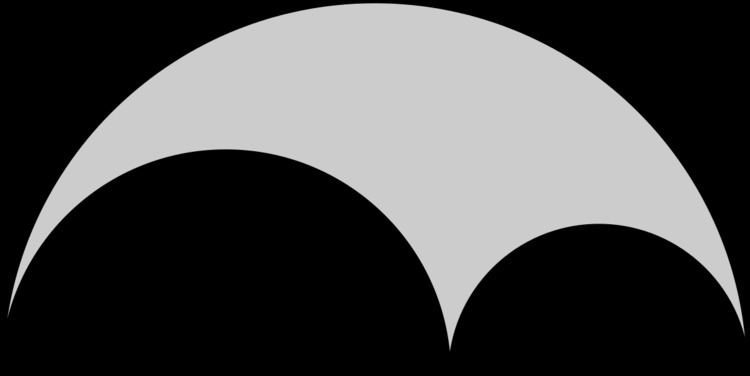In geometry, an arbelos is a plane region bounded by three semicircles connected at the corners, all on the same side of a straight line (the baseline) that contains their diameters.
The earliest known reference to this figure is in the Book of Lemmas, where some of its mathematical properties are stated as Propositions 4 through 8.
Two of the semicircles are necessarily concave, with arbitrary diameters a and b; the third semicircle is convex, with diameter a+b.
The area of the arbelos is equal to the area of a circle with diameter H A .
Proof: For the proof, reflect the line through the points B and C , and observe that twice the area of the arbelos is what remains when the areas of the two smaller circles (with diameters B A A C ) are subtracted from the area of the large circle (with diameter B C ). Since the area of a circle is proportional to the square of the diameter (Euclid's Elements, Book XII, Proposition 2; we do not need to know that the constant of proportionality is π 4 ), the problem reduces to showing that 2 ( A H ) 2 = ( B C ) 2 − ( A C ) 2 − ( B A ) 2 . The length ( B C ) equals the sum of the lengths ( B A ) and ( A C ) , so this equation simplifies algebraically to the statement that ( A H ) 2 = ( B A ) ( A C ) . Thus the claim is that the length of the segment A H is the geometric mean of the lengths of the segments B A and A C . Now (see Figure) the triangle B H C , being inscribed in the semicircle, has a right angle at the point H (Euclid, Book III, Proposition 31), and consequently ( H A ) is indeed a "mean proportional" between ( B A ) and ( A C ) (Euclid, Book VI, Proposition 8, Porism). This proof approximates the ancient Greek argument; one many find the idea implemented as a proof without words.
Let D and E be the points where the segments B H and C H intersect the semicircles A B and A C , respectively. The quadrilateral A D H E is actually a rectangle.
Proof: The angles
B D A ,
B H C , and
A E C are right angles because they are inscribed in semicircles (by Thales' theorem). The quadrilateral
A D H E therefore has three right angles, so it is a rectangle.
Q.E.D.The line D E is tangent to semicircle B A at D and semicircle A C at E .
Proof: Since angle BDA is a right angle, angle DBA equals π/2 minus angle DAB. However, angle DAH also equals π/2 minus angle DAB (since angle HAB is a right angle). Therefore triangles DBA and DAH are similar. Therefore angle DIA equals angle DOH, where I is the midpoint of BA and O is the midpoint of AH. But AOH is a straight line, so angle DOH and DOA are supplementary angles. Therefore the sum of angles DIA and DOA is π. Angle IAO is a right angle. The sum of the angles in any quadrilateral is 2π, so in quadrilateral IDOA, angle IDO must be a right angle. But ADHE is a rectangle, so the midpoint O of AH (the rectangle's diagonal) is also the midpoint of DE (the rectangle's other diagonal). As I (defined as the midpoint of BA) is the center of semicircle BA, and angle IDE is a right angle, then DE is tangent to semicircle BA at D. By analogous reasoning DE is tangent to semicircle AC at E.
Q.E.D.The altitude A H divides the arbelos into two regions, each bounded by a semicircle, a straight line segment, and an arc of the outer semicircle. The circles inscribed in each of these regions, known as the Archimedes' circles of the arbelos, have the same size.
The name arbelos comes from Greek ἡ ἄρβηλος he árbēlos or ἄρβυλος árbylos, meaning "shoemaker's knife", a knife used by cobblers from antiquity to the current day, whose blade is said to resemble the geometric figure.

